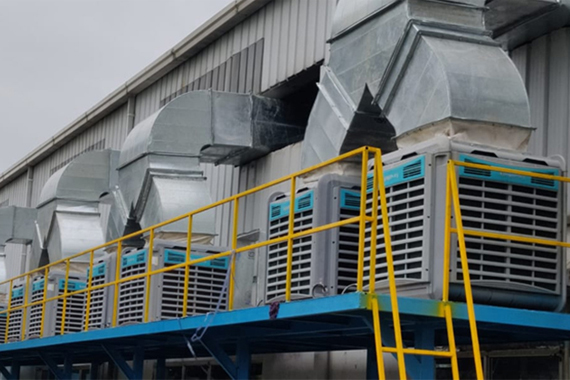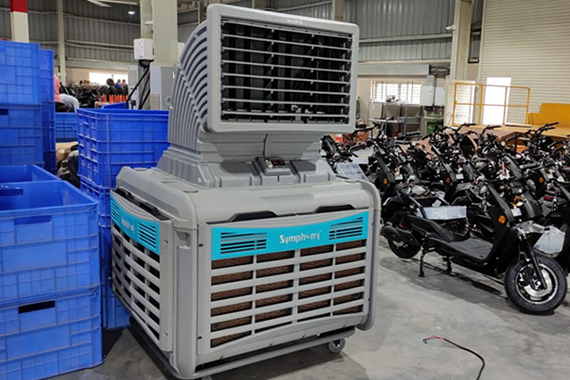The Comprehensive Guide to Duct Air Coolers: Benefits, Considerations, and FAQs

In the realm of cooling solutions, duct air coolers stand out as versatile, efficient, and cost-effective alternatives to traditional air conditioning systems. Whether for industrial spaces, offices, or homes, duct air coolers offer a range of benefits that make them a compelling choice for cooling needs. In this comprehensive guide, we delve into the advantages of duct air coolers, key considerations before purchase, and address common queries to help you make an informed decision.
Benefits of Duct Air Coolers:
Versatility Across Spaces: Duct air coolers cater to diverse space requirements, from expansive factory floors to intimate home environments. With various capacities available, consumers can easily select a model tailored to their specific needs.
Low Maintenance: Unlike air conditioners, duct air coolers entail minimal maintenance costs. The primary consumable component is the cooling pads, typically requiring replacement every 3-4 years under favourable water quality conditions. This translates to long-term savings and peace of mind for consumers.

Enhanced Cooling Efficiency: Particularly effective in arid climates, duct air coolers excel in cooling large areas. The ability to extend duct length allows for targeted air distribution, ensuring optimal cooling wherever needed. This flexibility in placement enhances comfort and convenience for users.
Silent Operation: Duct air coolers operate quietly, creating a conducive environment for work or relaxation. By evenly distributing air parallel to the target angle, these coolers facilitate gradual and noise-free cooling, minimizing disruptions in surrounding spaces.
Healthier Indoor Environment: By promoting cross-ventilation and constant air circulation, duct air coolers contribute to a healthier indoor atmosphere compared to air conditioners. This continuous airflow helps prevent the stagnation of air, reducing the risk of airborne contaminants and enhancing overall air quality.
Aspects to Consider Before Buying:
Cooling Capacity and CFM: Assessing the cooling capacity and airflow (measured in cubic feet per minute, CFM) ensures that the chosen duct air cooler adequately meets the cooling requirements of the intended space.
Cooling Pads: Consider the quality and longevity of the cooling pads, as they directly influence cooling efficiency and maintenance frequency.
Water Tank Capacity: Opt for a duct air cooler with a sufficient water tank capacity to sustain continuous operation without frequent refills, especially in high-usage scenarios.
Portability: Evaluate the portability features of the cooler, such as wheels or handles, to facilitate ease of movement and installation across different locations.
Installation and Maintenance: Prioritize models with straightforward installation procedures and accessible maintenance requirements to minimize inconvenience and associated costs over time.
Material Quality: Examine the construction materials to ensure durability, corrosion resistance, and longevity of the duct air cooler, particularly in demanding environments.
Pricing: While considering budget constraints, weigh the initial investment against long-term savings and performance benefits to determine the best value proposition.
FAQs About Duct Air Coolers
Yes, duct air coolers are highly efficient in cooling large industrial spaces. Their ability to extend duct length allows for targeted air distribution, ensuring comprehensive cooling coverage throughout expansive areas.
Cooling pads typically require replacement every 3-4 years, provided the water quality is favourable. Regular maintenance and periodic inspection can help prolong the lifespan of cooling pads and optimize cooling performance.
Yes, duct air coolers are well-suited for residential applications. They offer a cost-effective and eco-friendly cooling solution, providing comfort and improved air quality without the high energy consumption associated with traditional air conditioners.
The water consumption of duct air coolers varies depending on factors such as usage patterns, ambient temperature, and humidity levels. However, modern models are designed to maximize efficiency and minimize water consumption, ensuring sustainable operation.
Yes, duct air coolers can complement existing HVAC systems, especially in environments where additional cooling capacity or targeted airflow is required. Integrating duct air coolers into HVAC setups can enhance overall cooling performance and energy efficiency.
Conclusion:
Duct air coolers offer a myriad of benefits, ranging from versatility and cost-effectiveness to enhanced cooling efficiency and environmental friendliness. By considering key factors such as cooling capacity, maintenance requirements, and material quality, consumers can make informed decisions when purchasing duct air coolers. With their silent operation, healthier indoor environment, and suitability for diverse applications, duct air coolers emerge as compelling cooling solutions for both commercial and residential spaces.



